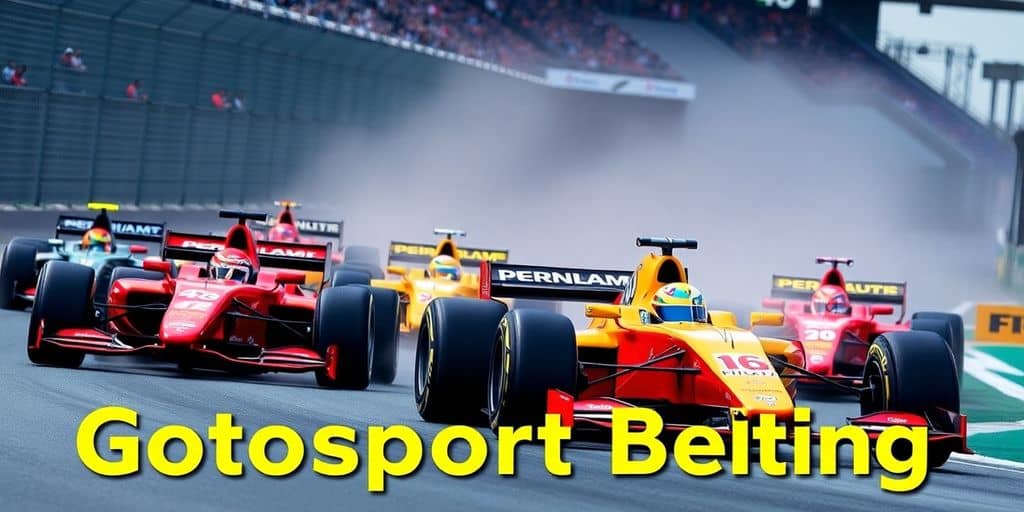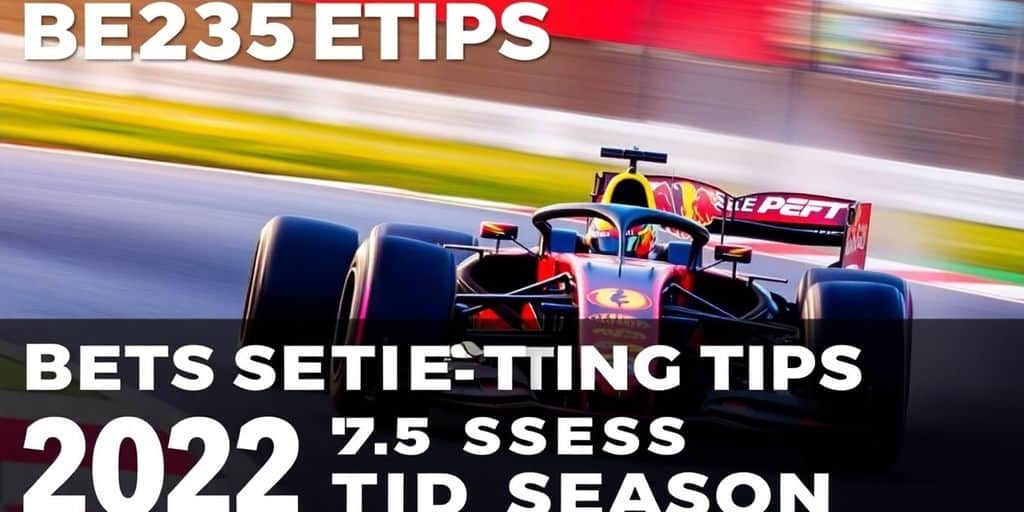Betting on Formula 1 can be thrilling, but it also requires a solid understanding of the sport and its unique variables. As the 2025 season approaches, knowing how to navigate the betting landscape will help you make smarter wagers. From understanding odds to analyzing driver performance, this guide will provide you with essential tips and strategies for mastering F1 betting.
Key Takeaways
- Always check qualifying results before placing race bets since starting position can heavily influence outcomes.
- Consider track characteristics and driver strengths when betting on specific circuits.
- Stay updated on team dynamics and any recent upgrades that could impact performance.
- Weather conditions can dramatically affect race outcomes, so monitor forecasts closely.
- Look for unique prop bets that may offer better value than standard race winner markets.
Understanding F1 Betting Odds and Market Types

F1 betting can seem complex at first, but breaking down the odds and market types makes it way easier to get into. It’s not just about picking the winner; there’s a whole range of bets you can explore. Let’s look at some of the most common ones.
Race Winner
This is the most straightforward bet: you’re simply picking who will win the race. Odds are usually displayed in decimal or fractional format, showing the potential payout for each driver. The favorite will have the lowest odds, while long shots have higher odds, meaning a bigger potential return but a lower chance of winning. It’s a classic for a reason.
Podium Finish Options
Instead of just betting on the winner, you can bet on a driver to finish in the top three. This gives you a bit more leeway, especially if you’re backing a driver from a team like Aston Martin or McLaren. The odds will be lower than betting on a race winner, but your chances of winning are higher. You might also find options to bet on a driver to finish in the top 6 or top 10, which are good for drivers who consistently score points but aren’t likely to win. These futures bets can be placed well in advance.
Head-to-Head Matchups
In this type of bet, the sportsbook pairs two drivers, and you bet on which one will finish higher in the race. It doesn’t matter where they finish overall, just who beats the other. These matchups are often based on driver skill, car performance, and team strategy. Factors like qualifying position and tire choices also play a big role. It’s a good way to use your knowledge of the sport to predict individual performances, and can be a good alternative to outright winner bets if you have a strong feeling about one driver’s performance relative to another.
Understanding the nuances of each betting market is key to making informed decisions. Consider factors like track characteristics, weather conditions, and team form before placing your bets. Don’t just go with the favorites; look for value in the underdogs and consider the different types of bets available to maximize your chances of winning.
Types of F1 Prop Bets
Prop bets, or proposition bets, add a layer of excitement to Formula 1 wagering beyond simply picking the race winner. They focus on specific events or outcomes within the race, offering a variety of ways to get involved. Prop markets in F1 can vary by sportsbook, but here are some of the most common types you’ll find.
Fastest Lap Predictions
This is a straightforward prop: which driver will set the fastest lap during the race? Often, teams will instruct their drivers to go for it near the end of the race when they have a comfortable lead and fresh soft tires. Keep an eye on drivers known for their late-race pace and those with nothing to lose.
Top Finish Markets
Instead of betting on a driver to win, you can wager on whether they’ll finish inside the top 3, top 6, or top 10. This is a good option for backing drivers from teams like Aston Martin or McLaren. It gives you a bit more wiggle room than picking an outright winner. These top finish markets are ideal when backing drivers from second-tier teams.
Safety Car Props
Will there be a safety car period during the race? This prop is influenced by the track layout and weather conditions. Street circuits and races with a high chance of rain are more likely to see a safety car. Consider these factors when making your pick. Here are some things to consider:
- Track layout: Narrow tracks increase the chance of incidents.
- Weather: Rain often leads to more crashes and safety cars.
- Past races: Review previous races at the same track for safety car history.
Betting on F1 props requires more than just knowing the drivers. It’s about understanding the nuances of each race and how small advantages can translate into profits. Props reward those who can anticipate race developments and capitalize on market inefficiencies.
Formula 1 Props Tips and Strategy

Becoming a good F1 bettor means knowing that every track, every car, and even the weather can change things. Here are some key strategies to help you stay ahead.
Track-Specific Specialists
Some drivers and teams just do better at certain tracks. It’s a real thing. For example:
- Monaco (Street circuit): Pole position is super important here because it’s hard to pass. So, bet on teams that are good at qualifying.
- Monza (High-speed circuit): Teams with powerful engines often do well here. Think Ferrari or Mercedes.
- Spa-Francorchamps (Long, fast corners): Aerodynamic efficiency is key. Red Bull usually shines here. You can find top odds for these races.
Momentum and Team Form
F1 teams are always making changes to their cars. A new part can make a big difference in lap times. Keep an eye out for:
- Mid-season upgrades: Teams will announce these during practice sessions.
- Team momentum: Is a team getting better, or are they falling behind? McLaren’s improvement in the summer of 2023 is a good example.
- Driver consistency: Some drivers are just more reliable than others.
It’s important to look at the bigger picture. Don’t just focus on last week’s race. Look at the overall trend.
Avoiding Early-Week Betting
F1 is not like other sports. Things change a lot over a race weekend. Betting on Tuesday for a Sunday race without seeing practice or qualifying is basically guessing. Instead:
- Wait for FP2 and FP3: Use these practice sessions to get an idea of race pace.
- Check long-run pace: See how the cars are doing over longer distances.
- Consider trackside conditions: Is it hot? Is it windy?
Use this data before you make any bets. It’s worth the wait.
Key Stats and Data Points for Prop Betting
To really crush F1 prop bets, you can’t just be a casual fan. You need to back up your hunches with solid data. Successful prop bettors use hard data to inform their strategy.
Qualifying Pace vs. Race Pace
Some teams are quick in qualifying but struggle during the race. Think about it: a team might nail a fast lap on Saturday, but then their tires go off a cliff on Sunday. If you’re betting on head-to-head matchups or top-10 finishes, this difference is super important. You gotta know which cars can maintain their speed over a full race distance.
Tire Wear and Strategy Trends
Tire management is everything in F1. Some teams are just better at it than others. Keep an eye on which teams do well on tracks known for eating tires. Look at past races and Friday practice runs to see how teams manage their tires over long stints. This can give you a big edge when betting on things like pit stop strategy or whether a certain driver will finish in the points. For example, Mercedes and Aston Martin often shine on high-degradation circuits.
Weather Forecast Impacts
Rain races are wild cards, and that means opportunity for prop bettors. When the weather gets crazy, anything can happen. Suddenly, those long-shot bets on things like "first driver to retire" or "top 6 finish" become a lot more realistic.
Mixed conditions create chaos, which can turn long-shot props into sharp plays. Books often delay odds updates on sudden weather shifts — creating value windows.
Here’s what to look for:
- Wet-weather specialists like Hamilton and Alonso gain value when rain hits.
- Rookies or error-prone drivers can be fade targets in unpredictable conditions.
- Remember the 2024 Brazilian Grand Prix: Verstappen surged from P16 to P3 in the rain.
Maximizing Value in F1 Betting
Analyzing Driver Form
Okay, so you want to make some smart bets? Start by really looking at how the drivers are doing. Don’t just look at who won last race. Is a driver consistently getting better lap times? Are they good at certain types of tracks? This stuff matters. A driver might have had one lucky win, but that doesn’t mean they’re suddenly amazing. Look at their whole season, their past performance on similar tracks, and any patterns you can find. This is how you find real value, not just betting on the hype.
Historical Performance Insights
Dig into the past! Seriously, historical data is your friend. How has a driver performed at this specific track before? What about the team? Some teams just do better at certain races, and it’s not always obvious why. Look at weather conditions from past races, too. Some drivers excel in the rain, others fall apart. Use this info to make smarter calls. Don’t just guess based on what happened last week.
Understanding Team Dynamics
Team dynamics are huge. Is there a clear number one driver? Are the teammates constantly fighting each other for position? This stuff affects race outcomes. If a team favors one driver, that driver is more likely to get the better strategy and support. Also, pay attention to team upgrades. A new part on the car can make a big difference, but it might only benefit one driver. Understanding these dynamics can give you an edge in head-to-head bets and other prop bets. Remember to gamble responsibly and set limits for yourself.
It’s easy to get caught up in the excitement of F1 betting, but always remember to stay objective. Don’t let your personal favorite driver or team cloud your judgment. Stick to the data, analyze the trends, and make informed decisions. That’s how you maximize your chances of winning.
Here’s a simple table to illustrate how historical data can be useful:
| Driver | Track (e.g., Monaco) | Avg. Finish | Wet Race Performance |
|---|---|---|---|
| Driver A | Monaco | 5th | Excellent |
| Driver B | Monaco | 12th | Poor |
| Driver C | Monaco | 3rd | Average |
This kind of quick reference can help you spot potential value bets quickly.
Navigating F1 Betting Platforms
Choosing where to place your bets is almost as important as deciding who to bet on. There are a ton of options out there, and they aren’t all created equal. You want a platform that’s reliable, offers good odds, and makes it easy to get your money in and out. Let’s break down what to look for.
Choosing the Right Sportsbook
Finding the right sportsbook is key. It’s not just about picking the one with the flashiest ads. Look for these things:
- Reputation and Licensing: Make sure the sportsbook is licensed and regulated. This means they’re held to certain standards and your money is (relatively) safe. Read reviews and see what other bettors are saying.
- Odds and Markets: Compare the odds offered by different sportsbooks. Even small differences can add up over time. Also, check if they offer the types of F1 bets you’re interested in, like safety car props or fastest lap bets.
- User Experience: The platform should be easy to use, both on desktop and mobile. A clunky interface can lead to mistakes and frustration.
It’s a good idea to have accounts at multiple sportsbooks. This lets you shop around for the best odds on each race and take advantage of different promotions.
Understanding Betting Formats
Betting odds can be displayed in different formats, and it’s important to understand them all. The most common are:
- Decimal Odds: These are the easiest to understand. They represent the total payout for every $1 wagered. For example, odds of 2.50 mean a $1 bet will return $2.50 (including your stake).
- Fractional Odds: Common in the UK, these show the profit relative to the stake. For example, 6/4 means you’ll win $6 for every $4 you bet.
- American Odds: These are displayed with a plus or minus sign. A plus sign (+) indicates the amount you’d win on a $100 bet. A minus sign (-) indicates the amount you need to bet to win $100.
It might seem confusing at first, but once you get the hang of it, it’s pretty straightforward. Most sportsbooks let you switch between formats, so find the one you’re most comfortable with.
Managing Your Bankroll
This is probably the most important part of F1 betting, or any kind of betting, really. You need to set a budget and stick to it. Here are some tips:
- Set a Budget: Decide how much money you’re willing to lose and don’t go over that amount. Treat it as entertainment money, not an investment.
- Use a Staking Plan: Don’t bet the same amount on every race. A common strategy is to bet 1-5% of your bankroll on each bet, depending on your confidence level.
- Track Your Bets: Keep a record of your bets, including the stake, odds, and outcome. This will help you identify what’s working and what’s not.
Never chase your losses. It’s tempting to try and win back what you’ve lost, but this usually leads to bigger losses. If you’re on a losing streak, take a break and come back later.
In-Depth Analysis of F1 Races
Evaluating Track Characteristics
Every track is different, and that means some cars and drivers will naturally do better at some than others. Understanding these nuances is key to making smart bets. For example, Monaco is a tight, twisty street circuit where qualifying position is super important, while Monza is all about top speed and power. Consider these factors:
- Track length and layout
- Number and type of corners (high-speed, low-speed, chicanes)
- Average speed and top speed potential
- Surface grip levels
Assessing Weather Conditions
Weather can totally change a race. Rain, especially, can level the playing field and create chaos. Keep an eye on the forecast and consider how different drivers perform in the wet. Some drivers are just naturally better in those conditions. Also, changing temperatures can affect tire performance, which impacts strategy. You can check the F1 driver standings to see how weather affected previous races.
Reviewing Past Race Results
Looking at past races at a particular track can give you a good idea of which teams and drivers tend to perform well there. But don’t just look at the winner. Pay attention to:
- Qualifying results
- Race pace (how fast drivers were consistently lapping)
- Tire strategies used
- Any incidents or retirements that affected the outcome
It’s easy to oversimplify things and just look at who won last year. But digging deeper into the data will give you a much better understanding of the track and who’s likely to do well this time around. Remember that car development changes year to year, so weight recent results more heavily.
Final Thoughts on F1 Betting for 2025
So, there you have it. Betting on Formula 1 can be a wild ride, but with the right approach, you can definitely find some wins. Remember to keep an eye on the drivers, track conditions, and team strategies as the season unfolds. Don’t rush into bets too early in the week; wait for practice and qualifying results to guide your choices. And hey, don’t forget to have fun while you’re at it! Whether you’re a seasoned bettor or just starting out, the thrill of F1 racing combined with smart betting can make for an exciting season. Good luck out there!
Frequently Asked Questions
What are the main types of bets in F1 racing?
In F1 betting, you can place bets on who will win the race, whether a driver will finish in the top positions, and head-to-head matchups between two drivers.
What is a prop bet in F1?
Prop bets are special bets that focus on specific events during a race, like who will set the fastest lap or if a safety car will be used.
How can I improve my F1 betting strategy?
To improve your strategy, pay attention to driver performance, track conditions, and team updates. Avoid betting too early in the week without solid data.
Why is qualifying important in F1 betting?
Qualifying results are crucial because they determine starting positions. A good qualifying position often leads to a better chance of winning the race.
How does weather affect F1 races?
Weather can greatly impact race outcomes. Rain can change track conditions, making it harder for some drivers while benefiting others who excel in wet conditions.
What should I consider when choosing a sportsbook for F1 betting?
Look for a sportsbook that offers a variety of bet types, competitive odds, and reliable customer service. Make sure it’s easy to navigate and manage your bets.











